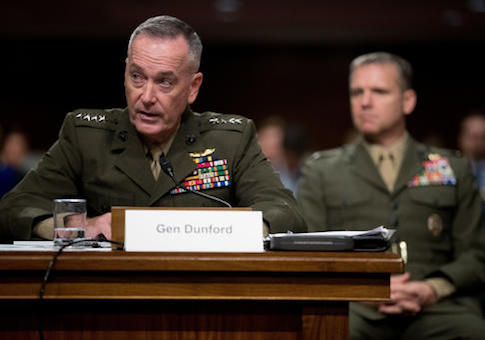Criminal and terrorist networks are evolving "out of view" of U.S. intelligence and increasingly cooperating to achieve their goals, according to a new document from the U.S. military that calls for a better coordinated effort between the Pentagon and other government agencies to counter threat networks.
It is becoming increasingly difficult for the United States to deter threats from transnational networks such as terrorist organizations and groups trafficking illicit goods, according to the document from the Joint Chiefs of Staff published in late December.
The Joint Publication 3-25, which was recently highlighted by the Federation of American Scientists, evaluated the United States' efforts to counter networks threatening U.S. interests at home and abroad, calling for more interagency work and partnerships with international organizations and allies to deter them.
"Traditional threats like insurgencies and criminal gangs have been exploiting weak or corrupt governments for years, but the rise of transnational extremists and their active cooperation with traditional threats has changed the global dynamic," the document dated Dec. 21, 2016, stated. "Successful deterrence and elimination of these illicit networks is more complicated and less predictable than in the past."
"Threat networks will adapt rapidly and sometimes 'out of view' of intelligence collection efforts," the document stated. "Intelligence sharing between USG [U.S. government] departments and agencies and PNs [partner nations] is vital. This must be complemented by integrated planning and execution to achieve the optimal operational tempo to defeat threats."
Threat networks include insurgent and terrorist groups such as al Qaeda and the Islamic State, as well as transnational criminal organizations and local criminal networks trafficking drugs, illicit arms, or people.
The military document was published before the inauguration of President Donald Trump, who has made building a wall at the southern border a key prong of his plan to stymie the flow of illegal substances and people into the United States. Trump has also pledged to "knock" out ISIS from its territory in Syria and Iraq, though his strategy for doing so remains unclear.
Secretary of Defense James Mattis and Secretary of Homeland Security John Kelly—both of whom were confirmed last week—will together be responsible for defending the United States and forces abroad from threat networks.
Increasingly, these networks have worked together to achieve their objectives, leading the intelligence community to label the convergence of terror, criminal, and insurgent networks a key national security threat.
"Conflict in Iraq and Afghanistan has seen a substantial increase in the cooperative arrangements of illicit networks to further their respective interests," the Joint Chiefs document stated. "From the Taliban renting their forces out to provide security for drug operations to al-Qaida using criminal organizations to smuggle resources, temporary cooperative arrangements are now a routine aspect of CTN [countering threat networks] operations."
The document said that such cooperation has not kept up with the evolving threat from terrorist and criminal networks. In it, military leaders also recommend the creation of a "joint interagency coordination group" to streamline operations against threat networks across government entities, including the Pentagon.
"Operations against threat networks require unity of effort across the USG and multiple authorities outside DOD. Multiple instruments of national power will be operating in close proximity and often conducting complementary activities across the strategic, operational, and tactical levels," the document stated.
"In order to integrate, deconflict, and synchronize the activities of these multiple entities, the commander should form a joint interagency coordination group, with representatives from all participants operating in or around the operational area."
The senior military leaders of the Joint Chiefs of Staff, chaired by Gen. Joseph Dunford, advise the president, defense secretary, and National Security Council on defense matters.
